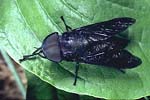 Description: 3/4-1 1/8" (20-28 mm). Large, broad. Head tan to ash-gray between large green eyes and on rear surface. Antennae reddish brown. Thorax brownish to blackish with gray hair. Abdomen is blackish red-brown with short gray hair across rear margin. Hind tibiae do not have spurs. Wings smoky; brown to black near base.
Description: 3/4-1 1/8" (20-28 mm). Large, broad. Head tan to ash-gray between large green eyes and on rear surface. Antennae reddish brown. Thorax brownish to blackish with gray hair. Abdomen is blackish red-brown with short gray hair across rear margin. Hind tibiae do not have spurs. Wings smoky; brown to black near base.
- Warning When the female bites, the wound inflicted often continues to bleed for several minutes because the fly's saliva contains an anticoagulant that prevents clotting. A single animal may suffer a debilitating loss of blood if many of these insects attack it.
- Food Male eats pollen and nectar; female takes blood of large mammals. Larva preys on aquatic insects and other small animals.
- Life Cycle Eggs masses are attached to plants overhanging fresh water, into which larvae drop. Larvae over winter in muddy bottom 2 winters, they pupate in spring. Males are short-lived, but females may survive until fall.
- Habitat Near swamps, marshes, and ponds.
- Range Newfoundland to Florida, west to Texas and northern Mexico, north to Canadian Northwest Territories.